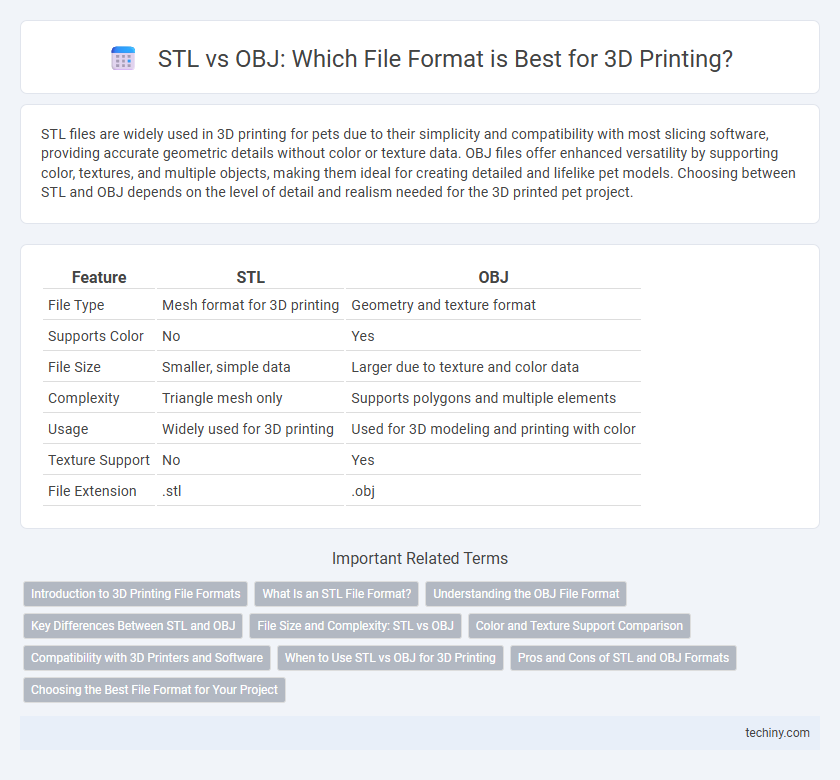STL files are widely used in 3D printing for pets due to their simplicity and compatibility with most slicing software, providing accurate geometric details without color or texture data. OBJ files offer enhanced versatility by supporting color, textures, and multiple objects, making them ideal for creating detailed and lifelike pet models. Choosing between STL and OBJ depends on the level of detail and realism needed for the 3D printed pet project.
Table of Comparison
| Feature | STL | OBJ |
|---|---|---|
| File Type | Mesh format for 3D printing | Geometry and texture format |
| Supports Color | No | Yes |
| File Size | Smaller, simple data | Larger due to texture and color data |
| Complexity | Triangle mesh only | Supports polygons and multiple elements |
| Usage | Widely used for 3D printing | Used for 3D modeling and printing with color |
| Texture Support | No | Yes |
| File Extension | .stl | .obj |
Introduction to 3D Printing File Formats
STL and OBJ are two of the most common file formats used in 3D printing, each serving specific purposes within the design and manufacturing process. STL files store only surface geometry using triangular facets, making them ideal for precise manufacturing but lacking color and texture information. OBJ files support complex geometry along with detailed color, texture, and material data, which benefits designers requiring high visual fidelity and multi-material printing capabilities.
What Is an STL File Format?
An STL file format, standing for stereolithography, is the most widely used file type in 3D printing that represents a 3D object's surface geometry through a mesh of triangles without any color or texture information. This format is highly compatible with most 3D printers and slicing software due to its simplicity and focus on shape accuracy. STL files are essential for converting digital models into physical prints by providing precise geometric data that guides the printer during the fabrication process.
Understanding the OBJ File Format
The OBJ file format is widely used in 3D printing due to its ability to represent complex 3D geometry with detailed vertex, texture, and normal information. Unlike STL files, which primarily store surface geometry as triangles, OBJ files support polygonal data, allowing for more intricate and accurate models. This capability makes OBJ ideal for applications requiring detailed surface textures and color information in 3D printed objects.
Key Differences Between STL and OBJ
STL files store 3D models as a mesh of triangles, primarily encoding shape geometry without color or texture data, making them ideal for 3D printing applications. OBJ files support polygonal geometry and include detailed information such as color, textures, and material properties, enabling more complex visual representations suitable for rendering and design workflows. The choice between STL and OBJ depends on the need for surface detail and visual elements versus a simple, universally supported format for 3D printing.
File Size and Complexity: STL vs OBJ
STL files typically have larger file sizes due to their representation of 3D models as a collection of triangular facets without color or texture data, which can increase complexity and slow down processing. OBJ files store geometry with additional information such as color, texture, and material, often resulting in smaller file sizes for complex models while maintaining rich detail. Choosing between STL and OBJ depends on the balance between file size constraints and the need for detailed surface attributes in 3D printing projects.
Color and Texture Support Comparison
STL files support only geometry without color or texture data, making them ideal for simple 3D printing models focused solely on shape accuracy. OBJ files include detailed color and texture information, allowing for more realistic and visually complex prints suited for applications requiring surface detail and multicolor designs. Choosing OBJ over STL enhances the final print's aesthetic quality when color and texture reproduction are essential.
Compatibility with 3D Printers and Software
STL files remain the industry standard for 3D printing due to their widespread compatibility with most 3D printers and slicing software, supporting straightforward geometry representation. OBJ files offer enhanced compatibility with advanced 3D modeling programs by including color, texture, and material data, which some high-end printers and software can utilize for detailed prints. Choosing between STL and OBJ depends on the specific printer capabilities and software ecosystem, where STL ensures reliable basic prints and OBJ supports complex, textured models.
When to Use STL vs OBJ for 3D Printing
STL files are ideal for 3D printing due to their simplicity and widespread compatibility with slicing software, making them perfect for models requiring precise mesh geometry without color or texture. OBJ files excel when detailed surface information, including color, texture, and multiple objects, is essential, offering enhanced visual fidelity for complex prints. Choosing between STL and OBJ depends on the project's need for visual detail versus streamlined printing requirements.
Pros and Cons of STL and OBJ Formats
STL files are widely supported in 3D printing due to their simplicity and efficiency in representing solid models through triangular facets, making them ideal for accurate printing of mechanical parts but lacking color and texture information. OBJ files support complex color, texture, and material data, enhancing aesthetic detail for prototypes and artistic prints, though they are generally larger and require more processing power. Choosing between STL and OBJ depends on whether precision and broad compatibility (STL) or detailed visual representation (OBJ) are prioritized in the 3D printing project.
Choosing the Best File Format for Your Project
STL files dominate 3D printing due to their simplicity and widespread compatibility, ideal for precise geometric models without color or texture data. OBJ files support detailed textures and color information, making them suitable for projects requiring complex visual elements and post-processing customization. Choosing between STL and OBJ depends on the project's need for color, detail fidelity, and software compatibility, ensuring optimal print quality and workflow efficiency.
STL vs OBJ Infographic

 techiny.com
techiny.com